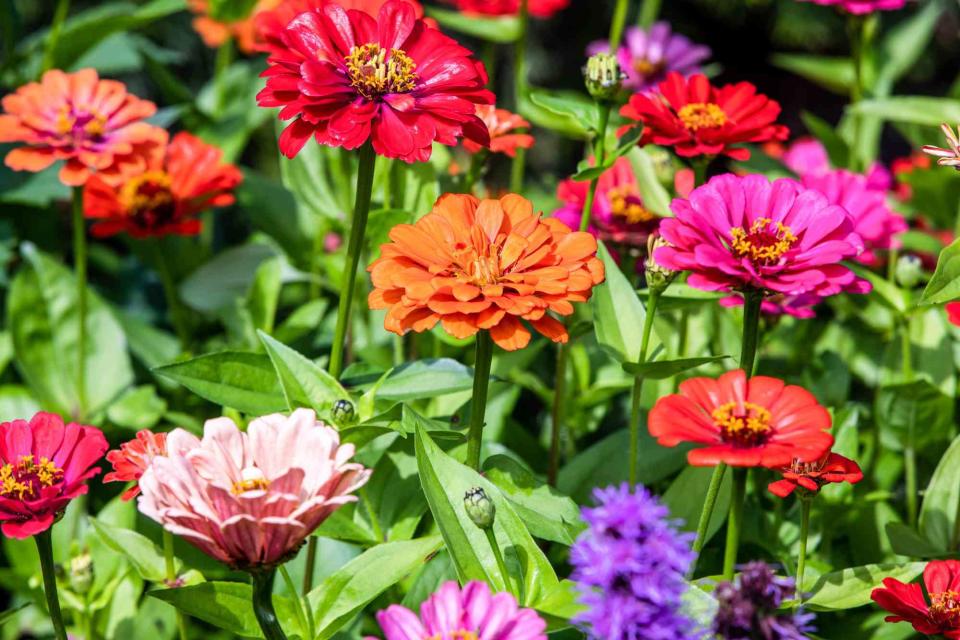The Difference Between Perennials and Annuals, According to Gardening Experts
These two common gardening terms are used to describe the growing cycle of plants.

Whether you have a garden or you're interested in starting one, you're likely familiar with the terms annual and perennial. Both are used to describe the growing cycle of plants, but knowing the difference between annuals and perennials (and their lesser-known counterpart, biennials) will help you understand which is better suited to your gardening style and help you plan your landscape's layout throughout the year. It will also dictate the type of care your plants need at key points during the growing season.
Meet the Expert
Kieran Avis, horticulturist at Longwood Gardens
Jeff Lorenz, founder of Refugia
Peggy Anne Montgomery, horticulturist with FlowerBulbs.com
Related: 14 Perennial Plants With Long-Lasting Flowers
What Is an Annual?
Annuals complete their life cycle in a single growing season and don't return again. "They are a great way to add color as well as texture to your garden in a near instant, as they tend to grow quickly," says Kieran Avis, horticulturist at Longwood Gardens. There are a few types of annuals you'll likely come across at your local plant nursery.
Cool-season annuals: These thrive in cooler temperatures and can be used to add interest to your garden during spring or fall. "Poppies, nigella, sweet peas, violas, and snapdragons are all great examples of cool-season annuals that will make your spring garden shine," says Avis.
Warm-season annuals: Also known as tender annuals, these plants enjoy the heat of summer. "Annual sunflowers, gomphrena, salvias, celosia, and zinnias are all great additions to make your summer garden stand out," says Avis. Many warm-season annuals are native to the tropics.
Self-sowing annuals: These regrow the following year from seeds instead of from their roots like a perennial would. "Plants will drop seeds in your garden once they are planted, and those seeds will germinate on their own the following year," says Avis. "Verbena bonariensis and some nicotiana are good examples of this."
What Is a Perennial?
A perennial is a plant that lives more than two years and regrows each spring. While the blooms and leaves of perennials die back during winter, new growth arises the following spring with minimal work on your part. "When sited correctly, perennials can be divided and moved around the garden to create a lush and immersive landscape that will return year after year," says Jeff Lorenz, the founder of Refugia. These plants are typically planted during fall or early spring. Common perennials include hellebores, peonies, forsythia, daylilies, poppies, black-eyed Susans, chrysanthemums, and hydrangeas.
What Is a Biennial?
Biennials are plants that take two growing seasons to flower. "They will send out herbaceous growth the first year followed by herbaceous growth and flowers the second year," says Avis. After their second year of life, they die—putting them right in the middle of annuals and perennials. However, like some annuals, certain biennial varieties drop seeds, perpetuating their life cycle in your garden. Common biennial plants include forget-me-nots, foxglove, and sweet William; several vegetables, including kale, Brussels sprouts, and cauliflower, are also biennia
Annual vs. Perennial vs. Biennial
Because they have different lifecycles, annuals, perennials, and biennials have their own unique benefits in the garden.
Benefits of Annuals
Annuals tend to have a long flowering period and showy blooms and add long-lasting color to cutting gardens and containers, says Peggy Anne Montgomery, horticulturist with FlowerBulbs.com. Many of these plants can be grown from seed, which is a fun and inexpensive way to start your garden. If you don't want to grow annuals from seed, they are also often sold in bloom, providing gardeners with instant gratification. "Many annuals are cold hardy and can be planted outdoors for early season color," she says.
Related: How to Start a Flower Garden, From Choosing Plants to Designing a Stunning Landscape
Benefits of Perennials
The biggest allure of perennials is that you only have to buy them once, while annuals are purchased every year. Perennials also increase in size and produce more and more flowers, so they can be divided and turned into more plants. "Perennials cost more than annuals but are a great investment because they don’t have to be replanted each year," says Montgomery.
Perennials are also beneficial for your landscape. "Perennials native to your location have the added benefit of providing specialized ecological functions, including being host plants for various types of insects," says Lorenz. Seed heads left around through winter also provide forage for wildlife and allow plants to self-seed throughout the garden. "These plants are also deeply rooted and are wonderfully efficient at managing stormwater in a way that most annuals do not," says Lorenz.
Benefits of Biennials
While you may feel impatient waiting for them to bloom, biennials offer the perfect mix of benefits. They regrow like perennials and are typically showy like annuals. "Biennials are another good tool to increase the beauty in your garden," says Avis. "It is important to supplement plantings yearly to ensure you have flowers every year, since biennials flower in their second season of growth."
Read the original article on Martha Stewart.

